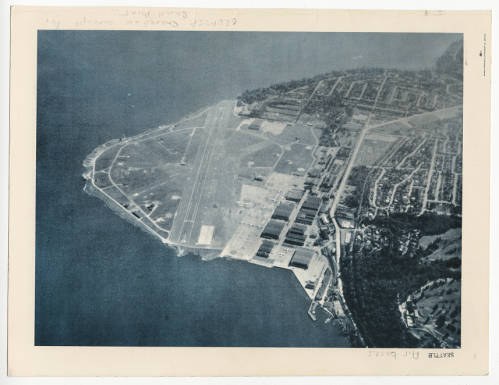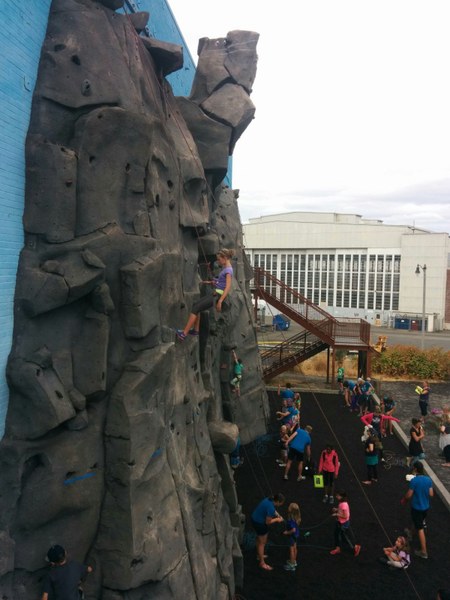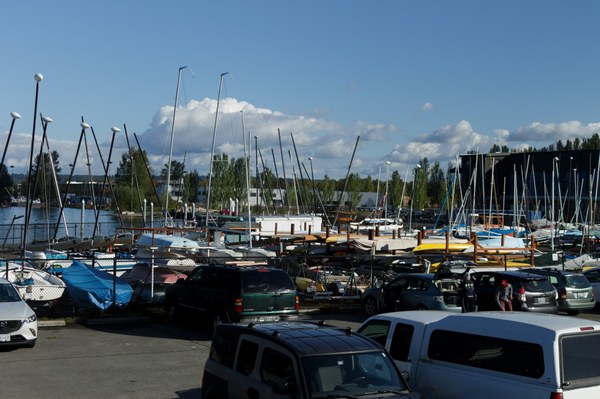
When I was little my parents enrolled me in summer sailing camp. My mother told me it was a necessary life skill that would be useful later on, but I was skeptical. Next thing I knew I was on a small boat with three other kids, floating into the middle of Lake Washington. We were packed in shoulder to shoulder, our red regulation life jackets up to our ears, my stomach bobbing up and down in tandem with the waves. We looked at each other with the same expression. “You guys know how to do this, right?” None of us did.
The camp was run by a gaggle of teenagers out of Magnuson Park’s boating center. The boating center building was long, wooden, and had white paint peeling off in clumps. Its structure clung to the side of a large concrete pier that extended into the water, struggling to stay afloat. I remember the concrete would heat up in the sun and burn my feet as I walked to the boats. Despite this, the pier was lively and crawled with teenagers all summer. My greatest summer memories are from Magnuson Park: summer camp at the pier, pee wee soccer at the fields next door, and climbing lessons at the gym between the airplane hangars.
When we are little, we assume everything around us is permanent. As we age, we watch the things we loved as a child evolve beyond recognition or disappear forever, and learn this isn’t the case. In fact, the opposite is true: the only certainty is change.
 Abbie enjoying the sunshine on a sailboat.
Abbie enjoying the sunshine on a sailboat.
Before Magnuson Park was named, people lived on the land. The Duwamish people inhabited the area since the last ice age when Lake Washington, “Big Lake” to Native peoples, was carved out by the Vashon ice sheet. For a while, the area remained untouched by white settlers even as the surrounding Puget Sound area was settled.
According to the U.S. Bureau of Land Management, the first survey of the area wasn’t conducted until 1855. William A. Strickler and a group of other surveyors combed the land systematically, scribbling in notebooks anything of importance to land development. William wrote in his report, “land gently rolling. Soil 1st rate in swamp, 2nd rate on upland. Timber, fir, cedar, Hemlock, Alder, Ash.” Everything was methodically ranked and cataloged.
This land, once described as rolling hills, is now sectioned off from the city by large brick walls. Outside the walls, four story buildings replaced fir and cedar; inside they continue to grow. Outside the city booms, as the walls protect and preserve what’s inside.
As a child I thought the walls were grand, towering over our blue hatchback. I would push my little face to the glass to soak it all in. The red brick and white trim reminded me of the university buildings by our house. I learned in my sixth-grade history class that the walls were built by the U.S. Navy. The Sand Point Naval Air Station was built in 1920, after the city was gifted the land in 1900. The shoreline was paved, massive steel hangars were brought in, and gates went up. The land changed quickly from wild, unencumbered nature to a groomed and manicured military base. The grass was measured and cut as often as the officer's hair.
 buildings on the perimeter of Magnuson Park.
buildings on the perimeter of Magnuson Park.
 Magnuson Park, 1955. Photo courtesy of THE SEATTLE PUBLIC LIBRARY.
Magnuson Park, 1955. Photo courtesy of THE SEATTLE PUBLIC LIBRARY.
My grandpa Rick was one of those officers, though maybe not as stoic. He had an aloofness and soft-spoken manner that makes me wonder how he ever barked orders. The Navy quickly realized his talents were more of the audio-visual variety. “When I was on duty in Norfolk (Virginia) it was my job to go get the film from the base and bring it back to the sub tender,” he explained. “You mean like a military film?” I asked. He chuckled, “No no, I was the entertainment guy.”
Following two years of active service, my grandpa spent his year of reserves fixing projectors in a basement of a control center at Magnuson. Before stationed at Sand Point, he was on the Olympic Peninsula at Fort Warren, a secluded and rustic base originally built to defend from Canadian attack. It was figured out quickly that was unnecessary. Still, there are gun towers pointed towards the Pacific, in defense of Washington land. “My buddy and I were hanging out one day by the gun towers,” my grandpa said. “There was this giant field. In the field there was a box. We opened the box and there was a ladder.” “A ladder?” I asked. “A ladder into the ground,” he continued, “and we climbed down and we were in a giant water drum, empty of course. But it was so echoey down there that when you spoke it felt like you were in the middle of a busy train station, but you were all by yourself.”
All over Magnuson Park, military bunkers are built into the side of hills. I wonder why the city never bothered to remove them. My grandpa thinks they’d have to be blasted out of the ground with dynamite. “The military builds things to last,” he says. I think of the box in the field and how it’s still there, waiting to be stumbled upon. My grandpa doesn’t remember the bunkers, but he does remember spending more time at the park picking me up from summer camps or attending soccer games than he did when it was a military base. I found this to be beautiful. He is someone that’s seen a place change and been lucky to experience both forms.
 Abbie climbing at the Seattle Program Center.
Abbie climbing at the Seattle Program Center.
The naval air station was closed in 1970, right after my grandpa finished his reserves. By 1977, the 300 acres had been divided up: 100 acres to the National Oceanic and Atmospheric Administration (NOAA) for a western headquarters and the remaining 200 acres to the city of Seattle. The park was named Magnuson after Washington State’s U.S. Senator, Warren G. Magnuson.
The following decades for the park were highlighted by a struggle for land use. The Muckleshoot Indian Tribe attempted to lay claim to the land and amateur pilots lobbied for continued use of the air strip, both with no success. Throughout this, the city continued with its plan to reuse the park. The airstrips became overgrown with wild grass and dandelions. The area adopted the name “Kite Hill,” from the dozens of little kids flying kites on the weekends. The officers quarters were converted into affordable housing, a colorful plastic playground installed in between the barracks. The command center my grandpa worked in now belongs to the University of Washington, housing their art history department and gallery. Navy Building 67 was eventually renovated to become The Mountaineers Seattle Program Center. The main airstrip and pier became the boating center where I would attend sailing camp.
 Sailboats at Magnuson Park.
Sailboats at Magnuson Park.
A shaky and over-exposed video from 1955 shows a naval plane taking off from the base. A pilot smiles and waves, his air traffic headset placed over a sturdy wool cap. The cameraman pans over the lake as they take flight, and you see everything. The concrete pier I ran down every summer, the long white boat house. It looks mostly identical, without the chipped paint and rust the building wears now. There are little specks of officers walking down the pier. I imagine them walking in between the teenagers on summer break or the Duwamish people paddling passed them in a canoe. The park’s history unfolds at once, and I see myself as a piece of the much larger puzzle. The hill behind the base, where there is now a dense neighborhood, is stark with fir trees. The plane gets higher and higher, revealing more of Seattle, how unpopulated it is compared to now, and I realize that Magnuson Park is the only thing I recognize. In some ways, my childhood assumptions were true. Magnuson Park is permanent, in one form or another. Now it stands as a portal back in time, amid an ever-changing city.
 Abbie Chipps
Abbie Chipps